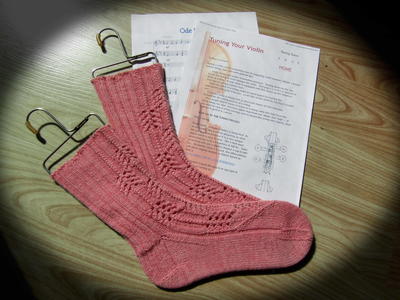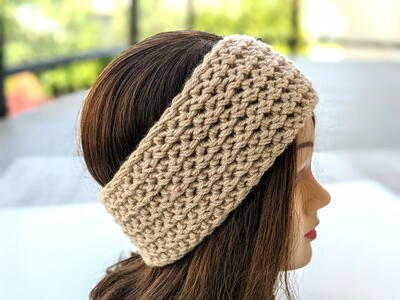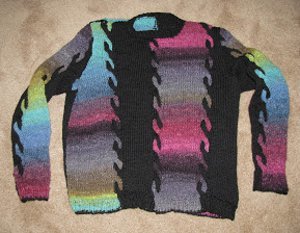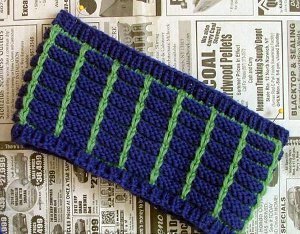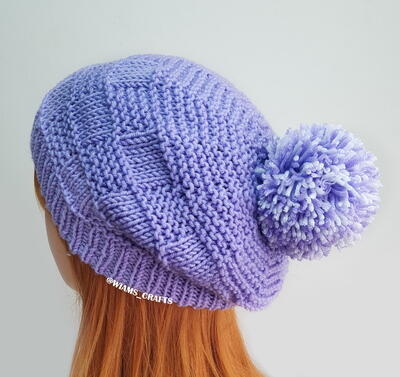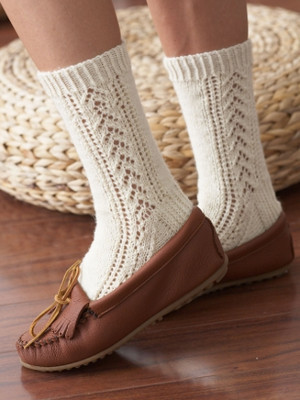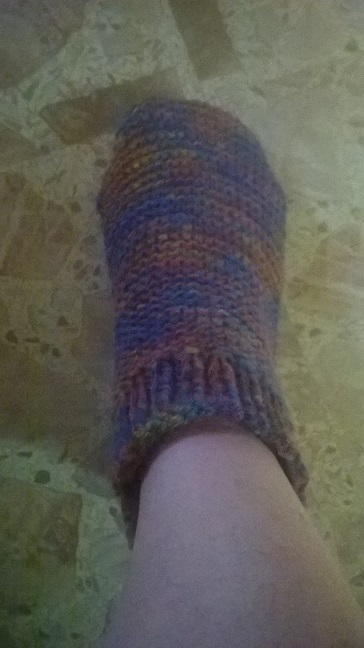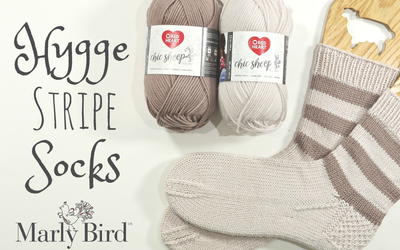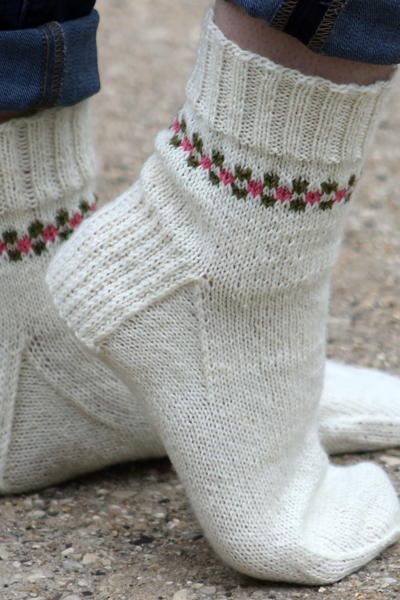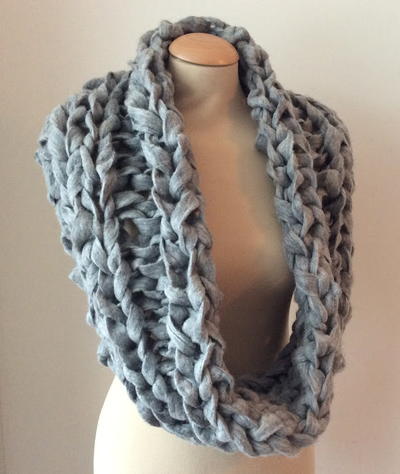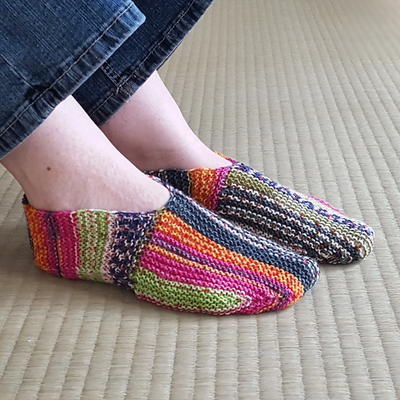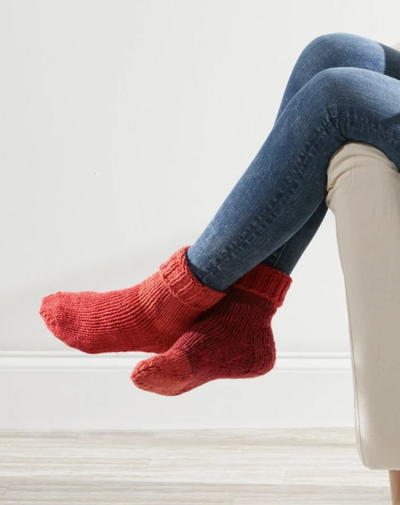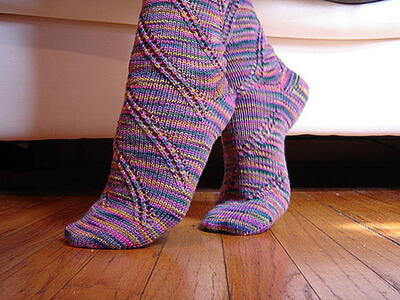This project was submitted by one of our readers, just like you.
Fine-Tuned Socks
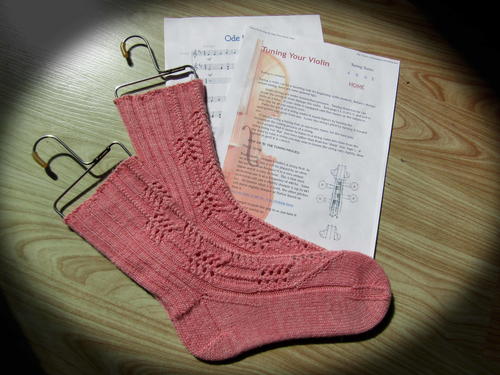
"If knitting were music, the stitches would be the keys and the repeats would be the time signature. If knitting were music, a simple two-by-two rib could be translated into the Key of C (No sharps or flats, just natural notes), in 2/2 time, (or cut time). Changing just a few stitches (the notes) to cables or lace (sharps or flats) the entire musical world is at your knitting fingertips. Waiting at the symphony, or the ballet, before the performance starts, each musician tunes their instrument. They do not listen to each other and from the audience it sounds like a mixed up medley of sounds until the conductor approaches and after the introduction and a moment of silence, those fine tuned instruments come together to create beautiful music. Fine Tuned Socks are the warm up in the orchestra pit. Twisted stitches and eyelet lace motifs, on the front, and a basic ribbed back of these cuff down socks, give you the best of the “ribbed socks fit so well” and “patterns socks seem to knit up so quickly” worlds and bring all the discordant tones of the orchestra warm-up together into a classic melody."

Knitting Needle Size1 or 2.25 mm
Yarn Weight(2) Fine (23-26 stitches to 4 inches)
Materials List
-
Knit Picks Stroll, 75% superwash merino/25% nylon, 231 yards [211 meters] 50 gms [1.76 ounces]
2 balls Dogwood Heather
-
St markers, large eyed tapestry needle for grafting and weaving in ends, optional sock blockers.
Instructions
Cuff: CO 64 sts, pm and join to begin working the round, being careful not to twist. (See Knotions Chinese Waitress Cast On Tutorial) Work the following 2 rnds a total of 10 times, or work from cuff chart, 20 rnds worked. (See Knotions chart reading tutorial) Rnd 1: K1, *p2, k2 repeat from* to last 3 sts, p2, k1. Rnd 2: K1 *p2, k2, p2, RT, repeat from *2 more times, *p2, k2, repeat from* to last 3 sts, p2, k1. Leg: Work Leg Chart across first 32 sts, second 32 sts are worked as: K 1, *p2, k2 from * to last 3 sts, p2, k1. Continuing in this manner, work leg chart rnds 1-32 across first 32 sts, keeping the second 32 sts in ribbing as established 2 times. (64 rnds of chart worked) Heel Flap: Set up row: Do not work the sts contained in the chart, immediately turn work and Sl1, p31. We will now work flat on those 32 sts. Row 1: *Sl1, k1 repeat from* across. Row 2: Sl1, p31. Repeat these two rows a total of 16 times. (32 rows worked) Turn the Heel: Row 1: Sl1, k18, ssk, k1 turn. Row 2: Sl1, p7, p2tog, p1 turn. Row 3: Sl1, k8, ssk, k1 turn. Row 4: Sl1, p7, p2tog, p1 turn. Repeat rows 3 & 4, working one additional st before each decrease until all sts have been worked. (20 sts on this needle.) K20, pick up and k17 sts along the gusset, pm, work rnd 1 of foot chart over the next 32 sts, pm , pick up and k17 sts along the gusset. K 10 sts to center heel. (Place a different m if desired, this is our start of round position. This m is not included in the Gusset or Toe instructions.) Gusset : Rnd 1: K to within 3 sts of the first m, k2tog, k1, sm, work foot chart across 32 sts, sm, k1, ssk, k to end of rnd. Rnd 2: K to first m, sm, work foot chart across 32 sts, sm, k to end of round. Repeat these two rounds until 32 sts rem in the sole. 64 sts total. (Leave the ms in for ease in working the toe decreases.) Checking foot length frequently, work foot chart rnds 1-56, across the instep and k all sts across the sole until 2.5 inches [6 cm] less than desired length. If additional length is desired upon completion of foot chart work the following across the instep sts until desired length. Rnd 1: K1, p2, k26, p2, k33. Toe: Rnd 1: K to within 3 sts of first m, k2tog, k1, sm, k1, ssk, k to within 3 sts of second m, k2tog, k1, sm, k1, ssk, k to end of rnd. Rnd 2: K across all sts. Work these two rnds 8 times, 32 total sts rem. Repeat rnd 1 (decrease row) 4 more times. (16 sts rem) K across to first m, resituate sts, if needed, so that all the instep sts are on one needle and all the sole sts are on another. Cut yarn, leaving a long tail and graft the two sides together using a Kitchener St. (See Knotions Kitchener Tutorial) Finishing Finishing: Weave in your ends, block if desired and unless you were working two at a time, k the other sock, taking care to match row counts from first sock.
Read NextRainbow Striped Knit Slipper Pattern
Your Recently Viewed Projects
tracie3101
Jul 08, 2017
I have been knitting off and on for several years however I am not I have been knitting off and on for several years and have been told I am very good however I don't really understand much other than knit and pearl. I was reading your instructions for the socks and it said "pm" I have NO idea what tham means it also said for demo see See Knotions Chinese Waitress Cast On Tutorial however I don't know where to find it. please help me if you can. My email address is tracie3101@nexicom.net and my name is Tracie Jackson. Thanx for your help
KathrynAllison
Jul 10, 2017
Hi tracie3101, "pm" stands for place marker. Also, you can find the tutorial referenced in the pattern by following this link: http://knotions.com/issues/april-2017/pattern-april-2017/fine-tuned-socks/. Hope this helps! -Kathryn, Editor of AllFreeKnitting
Report Inappropriate Comment
Are you sure you would like to report this comment? It will be flagged for our moderators to take action.
Thank you for taking the time to improve the content on our site.


